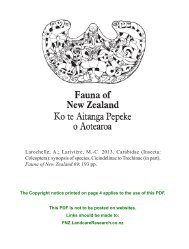PDF File, 693.8 KB - Landcare Research
PDF File, 693.8 KB - Landcare Research
PDF File, 693.8 KB - Landcare Research
You also want an ePaper? Increase the reach of your titles
YUMPU automatically turns print PDFs into web optimized ePapers that Google loves.
What’s New In Biological Control of Weeds Issue 48 May 2009<br />
Deciding Which Weeds to Target for Biocontrol<br />
Weeds are undoubtedly a growing<br />
problem. Typically the worst aff ected<br />
counties already have hundreds of species<br />
to manage, many sleeper weeds gradually<br />
beginning to wake up, and new species<br />
continually escaping from cultivation.<br />
Biocontrol is likely to be the only feasible<br />
way of managing widespread weeds,<br />
but, with so many species to tackle<br />
and inevitably limited resources, we<br />
need to fi nd better ways of prioritising<br />
where to direct our eff orts. Recently<br />
our team undertook a project for the<br />
Australian Government to come up with a<br />
framework for prioritising which weeds to<br />
target for biocontrol.<br />
First of all we reviewed all the ranking<br />
processes that have been used before in<br />
Australia, Canada, New Zealand, South<br />
Africa and the USA, the countries that<br />
have been most active in developing<br />
biocontrol programmes for weeds. “All<br />
of the systems used previously appeared<br />
to have limitations in that they relied too<br />
heavily on subjective judgements without<br />
adequate supporting justifi cation,”<br />
concluded Quentin Paynter, who was the<br />
mastermind behind this project. We also<br />
delved into the literature<br />
for papers that related<br />
biocontrol success to<br />
plant attributes and<br />
then had a major<br />
brainstorming session<br />
to decide on the best<br />
approach. As a result we<br />
identifi ed three factors<br />
that we believed<br />
needed to be taken<br />
into account.<br />
The fi rst factor to<br />
consider is the<br />
importance of the<br />
weed target. Things<br />
like how invasive<br />
is the weed, what<br />
impacts does it have, how fast is it<br />
spreading, how much land is at risk of<br />
invasion, and are other eff ective control<br />
methods available? This information<br />
was readily available for more than<br />
70 Australian weeds that had been<br />
assigned scores for these kinds of<br />
attributes through the Weeds of National<br />
Signifi cance (WoNS) ranking scheme<br />
undertaken a decade ago. Our project,<br />
therefore, concentrated on the remaining<br />
two factors.<br />
The second factor to consider is the<br />
eff ort required to undertake a project.<br />
For example if agents are not already<br />
well known, the native range is not<br />
friendly and accessible, and there are<br />
likely to be major confl icts of interest, a<br />
project is likely to have a lesser chance of<br />
succeeding. It is unfortunately a fact of life<br />
that very diffi cult and expensive projects<br />
are more likely fall by the wayside.<br />
The third factor to consider is the<br />
likely impact or success of biocontrol. At<br />
“So many weeds, so little money!”<br />
present the best predictor of the success<br />
of a biocontrol programme is what<br />
has happened in countries that have<br />
attempted it. However, for novel targets<br />
obviously we don’t have the luxury of a<br />
precedent, so we need another way of<br />
predicting success. In our literature search<br />
we collated all the hypotheses that people<br />
had proposed as to how various plant<br />
traits aff ect the likelihood of success. We<br />
made a list of these and then looked for<br />
evidence to back them up by studying<br />
published information about the success<br />
of biocontrol programmes completed<br />
in South Africa and the USA (see Table<br />
1). Data on the impact of biocontrol had<br />
been collected in a variety of ways, so to<br />
allow comparison Quent converted these<br />
data into an “impact index”, defi ned as the<br />
proportional reduction in weed density<br />
(e.g. percentage cover; stems/m2 ; weed<br />
biomass) due to biocontrol. The impact<br />
indices were then correlated with the<br />
range of factors that have been proposed<br />
as determinants of biocontrol success, to<br />
identify the important ones.<br />
5
















